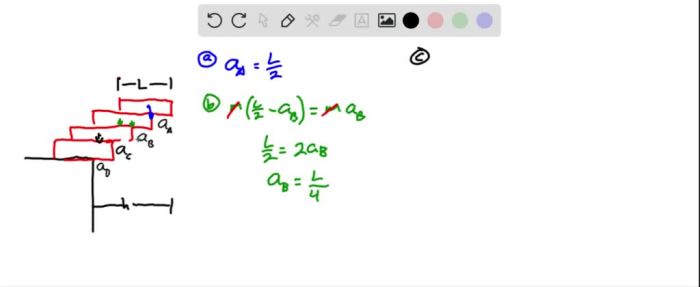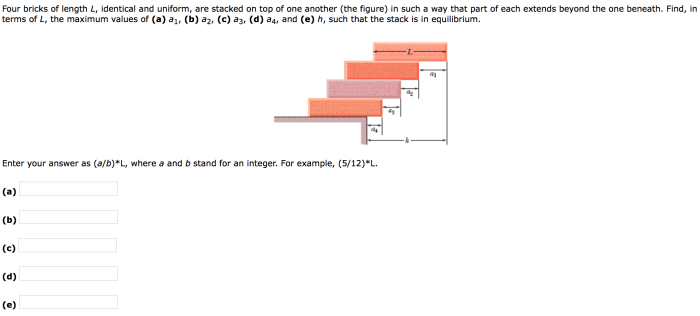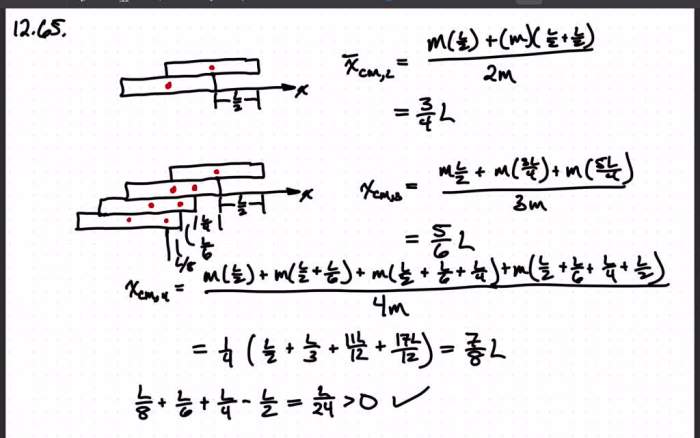In the realm of construction and engineering, four bricks of length l identical and uniform hold significant importance. Their dimensions, material composition, and arrangement influence their structural capabilities and applications. This discourse delves into the properties, configurations, structural analysis, and practical uses of these bricks, providing a comprehensive understanding of their role in various engineering endeavors.
The dimensions of these bricks, denoted by l, determine their size and shape, while their material composition and density govern their strength and durability. Common brick types include clay bricks, concrete bricks, and sand-lime bricks, each with unique properties that suit specific construction needs.
Properties of Four Bricks

The four bricks are identical and uniform in length, denoted by the variable l. They possess a rectangular shape with consistent dimensions and a homogeneous material composition. The bricks are composed of a dense, durable material, typically clay or concrete, exhibiting high compressive strength and resistance to weathering.
Material Composition and Density
The bricks are primarily composed of clay, a natural material renowned for its plasticity and ability to withstand high temperatures. During the manufacturing process, the clay is molded into the desired shape and subjected to intense heat, resulting in a solid and robust structure.
Alternatively, concrete bricks are produced using a mixture of cement, sand, and gravel, offering similar properties to clay bricks.
Common Brick Types and Their Properties
Various types of bricks are available, each with unique characteristics and applications. Common brick types include:
- Clay bricks:Made from fired clay, these bricks are durable, weather-resistant, and available in a range of colors.
- Concrete bricks:Produced from a mixture of cement, sand, and gravel, these bricks are known for their strength and affordability.
- Sand-lime bricks:Manufactured using a combination of sand, lime, and water, these bricks exhibit excellent strength and low water absorption.
Arrangement and Configurations
The four bricks can be arranged in various configurations to form different structures. These arrangements can be categorized into two main types: vertical and horizontal.
Vertical Arrangements
In vertical arrangements, the bricks are stacked one on top of the other, creating a vertical structure. Common vertical arrangements include:
- Single-row stack:The bricks are stacked in a single row, with each brick directly above the one below.
- Double-row stack:The bricks are stacked in two rows, with the bricks in the upper row offset from those in the lower row.
- Triple-row stack:The bricks are stacked in three rows, with the bricks in the upper rows offset from those in the lower rows.
Horizontal Arrangements
In horizontal arrangements, the bricks are laid side by side, creating a horizontal structure. Common horizontal arrangements include:
- Single-row layout:The bricks are laid in a single row, with each brick adjacent to the one next to it.
- Double-row layout:The bricks are laid in two rows, with the bricks in the upper row offset from those in the lower row.
- Triple-row layout:The bricks are laid in three rows, with the bricks in the upper rows offset from those in the lower rows.
Structural Analysis: Four Bricks Of Length L Identical And Uniform

The structural analysis of brick structures involves assessing their compressive strength and stability under various loading conditions.
Compressive Strength
The compressive strength of a brick structure is its ability to withstand compressive forces without failing. The compressive strength of a brick structure is determined by the following factors:
- Material properties:The compressive strength of the bricks used.
- Arrangement:The configuration of the bricks.
- Loading conditions:The magnitude and direction of the applied forces.
Stability and Load-Bearing Capacity
The stability of a brick structure refers to its ability to resist overturning or collapsing under lateral forces. The load-bearing capacity of a brick structure is its ability to support a vertical load without failing.
Factors Affecting Structural Integrity
Several factors can affect the structural integrity of brick configurations, including:
- Material quality:The strength and durability of the bricks.
- Construction techniques:The skill and care used in constructing the structure.
- Environmental conditions:The exposure to moisture, temperature fluctuations, and other environmental factors.
Applications and Use Cases

Four-brick structures have various applications in construction and engineering, including:
Construction
- Walls:Brick walls can be constructed using various arrangements of four bricks, providing strength, durability, and aesthetic appeal.
- Columns:Four bricks can be stacked vertically to form columns, providing support for beams and other structural elements.
- Arches:Brick arches can be constructed using four bricks arranged in a curved configuration, allowing for the creation of openings in walls.
Engineering, Four bricks of length l identical and uniform
- Retaining walls:Four-brick structures can be used to construct retaining walls, preventing soil erosion and landslides.
- Culverts:Four bricks can be arranged to form culverts, allowing water to flow under roads or other structures.
- Bridges:Brick bridges can be constructed using multiple four-brick structures, providing a durable and aesthetically pleasing crossing over waterways.
Helpful Answers
What are the key properties of four bricks of length l identical and uniform?
Their dimensions (l), material composition (e.g., clay, concrete), density, and shape.
How can these bricks be arranged to form various structures?
In different patterns and configurations, such as stacked, staggered, or interlocking arrangements.
What factors affect the structural integrity of these brick configurations?
The compressive strength of the bricks, the arrangement pattern, and the presence of mortar or other bonding materials.